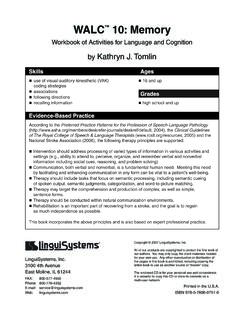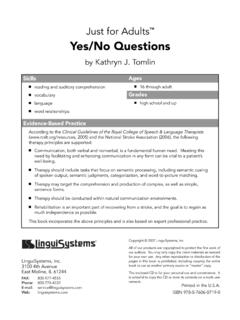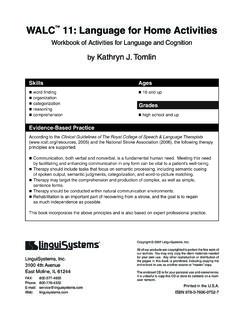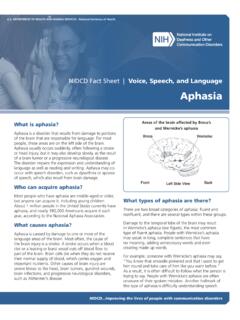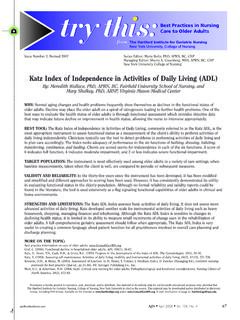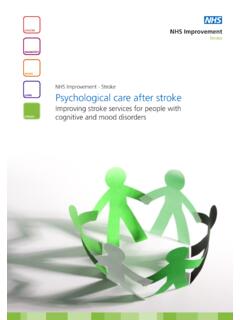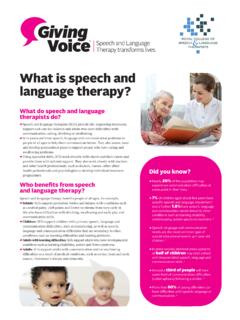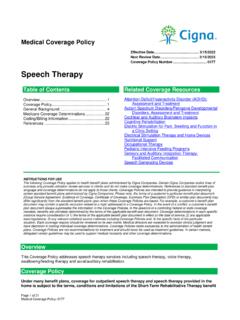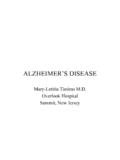Transcription of MedSLPCollective Handout - Assessing and Managing …
1 And Managing DysarthriaBackground: Dysarthria is a motor speech impairment that affects speech execution andcontrol. It results from an impairment in the motor neurons (upper and/or lower),neuromuscular junction, brain areas supporting speech feedback control ( , basal gangliaand cerebellum), or the speech musculature itself. Dysarthria is classified by theneuroanatomical structures affected (see Tables 1 and 2), and can affect any of the speechsubsystems (respiration, phonation, articulation, resonance, and prosody). Dysarthria is oneof the most common first signs of stroke (Table 1 details post-stroke dysarthria), but it canresult from many different neurological impairments, including traumatic injuries, tumors,degenerative processes ( , Parkinson s disease, Huntington s Disease, multiple sclerosis),and transient impairments ( , Bell s palsy).
2 Table 2 presents a summary of each dysarthria type, neuroanatomy implicated, andcommon etiologies. Tables 1 and 2 also include details pertaining to AOS to illustrate howthese motor speech impairments differ, and features that distinguish each disorder. Assessment and Differential Diagnosis Dysarthria assessment must include an oral mechanism/cranial nerve evaluation. ASHA spractice portal offers detailed procedures for Assessing dysarthria (see link below). Inaddition, your evaluation report should consider how the dysarthria impacts , consider how reduced intelligibility affects your patient s ability tocommunicate during emergency situations, verbalize important information regardinghis/her medical care, and engage in vocational and/or social activities.
3 Considering thesefactors will also help when developing functional treatment goals. Several assessment tools exist. These include: Frenchay Dysarthria Assessment-2nd Edition (FDA-2; Enderby & Palmer, 2008) Dysarthria Examination Battery (Drummond, 1993) Dysarthria Profile (Robertson, 1982) And tests of intelligibility Assessment of Intelligibility of Dysarthric Speech (AIDS; Yorkston et al., 1984) Speech Intelligibility Test (SIT; Beukelman et al., 2007) Mayo Clinic (informal) (Duffy, 2005). and Managing DysarthriaTreatment The goal of treatment is to improve the domain of production that has the greatest impacton intelligibility. Dworkin (1991) suggests a treatment hierarchy based on speech subsystems,where resonance and respiration are first order targets, phonation is a second order target, and prosody and articulation are third order targets.
4 The rationale here is a top-down approach, based on the interdependence of the speech subsystems. Targeting firstorder targets first is likely to have the greatest impact on intelligibility, and have downstream effects on the second and third order targets. Clark (2014) also discusses thattraining prosody, specifically phrasing of breath groups and lexical stress, may have asubstantial impact on intelligibility early in the course of treatment. With this in mind,treatments may focus on the following: improving respiratory support for speech (consider implementing diaphragmaticbreathing, postural adjustments, training inhalation/exhalation coordination for speech,using expiratory muscle trainers (Laciuga et al., 2014), phrase grouping strategies) Consideration of prosthetic device to manage resonance if appropriate.
5 Behavioralintervention for resonance may also include use of nasal mirrors or a See-Scape forbiofeedback while training resonance. Yorkston et al. (2001) provide detailed EBPregarding the management of velopharyngeal insufficiency in dysarthria. Phonation may be addressed through vocal function exercises (Stemple et al., 2014), Managing laryngeal strain (McCullough et al., 2012), or improving loudness with LeeSilverman Voice Treatment (LSVT, especially effective for hypokinetic dysarthria due toParkinson s disease (Mahler et al., 2015) Training over-articulation to improve intelligibility (Park et al., 2016) Using pacing strategies/metronome to target prosody (Blanchet & Snyder, 2010) This is not an exhaustive list of treatments, but a guide to get you started!)
6 In addition to thesuggestions above, goals may need to include the use of augmentative/alternativestrategies and environmental modification ( , reducing background noise, orcommunication partner training techniques). Early implementation of AAC in degenerativedysarthrias is especially important to give patients time to learn these strategies beforedegenerative processes progress. Refer to ASHA s practice portal and the references forgreater details on each of these approaches. As a reminder, treatment should NOT incorporate non-speech oral motor exercises forimproving speech production. There are several reasons for this: First, very little researchsupports the use of non-speech oral motor exercises for improving speech , other studies suggest that parts of the brain that are active during non-speechoral movements are only partially overlapping with those that are active during speechmotor movements (Basilakos et al.)
7 , 2018). Therefore, the use of non-speech oral motormovements to improve speech violates the specificity principle of plasticity (Kleim & Jones,2008). and Managing and Managing DysarthriaMixed dysarthrias are also possible in cases where pathology diffusely affects the brain. Someexamples include mixed dysarthrias that result from: multiple sclerosis (spastic-ataxic),amyotrophic lateral sclerosis (spastic-flaccid), multiple systems atrophy (hypokinetic-spastic-ataxic), progressive supranuclear palsy (hypokinetic-spastic-ataxic), and corticobasaldegeneration (hypokinetic-spastic; (Duffy, 2005). and Managing DysarthriaText References Basilakos, A., Smith, K., Fillmore, P., Fridriksson, J., & Fedorenko, E. (2018). Functionalcharacterization of the human articulation network.
8 Cerebral cortex, 28(5), 1816-1830. Beukelman, D., Yorkston, K., Hakel, M., & Dorsey, M. (2007). Speech intelligibility test. Computer software].(Madonna Rehabilitation Hospital, Lincoln, 2007). Kleim, J. A., & Jones, T. A. (2008). Principles of experience-dependent neural plasticity: implications for rehabilitation after brain damage. J Speech Lang Hear Res, 51(1), S225-239. Laciuga, H., Rosenbek, J. C., Davenport, P. W., & Sapienza, C. M. (2014). Functional outcomes associated with expiratory muscle strength training: narrative review. Journal of Rehabilitation Research & Development, 51(4), 535-546. Mahler, L. A., Ramig, L. O., & Fox, C. (2015). Evidence-based treatment of voice and speech disorders in Parkinson disease.
9 Current opinion in otolaryngology & head and neck surgery, 23(3), 209-215. McCullough, G. H., Zraick, R. I., Balou, S., Pickett, H. C., Rangarathnam, B., & Tulunay-Ugur, O. E. (2012). Treatment of laryngeal hyperfunction with flow phonation: A pilot study. Journal of Laryngology and Voice, 2(2), 64-69. Park, S., Theodoros, D., Finch, E., & Cardell, E. (2016). Be clear: A new intensive speech treatment for adults with nonprogressive dysarthria. American Journal of Speech-Language Pathology, 25(1), 97-110. Robertson, S. J. (1982). Robertson Dysarthria Profile. Buckinghamshire: Winslow. Stemple, J. C., Roy, N., & Klaben, B. K. (2014). Clinical voice pathology: Theory and management: Plural Publishing. Yorkston, K.
10 M., Beukelman, D. R., & Traynor, C. (1984). Assessment of intelligibility of dysarthric speech. Austin, TX: Pro-ed. Yorkston, K. M., Spencer, K., Duffy, J., Beukelman, D., Golper, L. A., Miller, R., Sullivan, M. (2001). Evidence-based practice guidelines for dysarthria: Management of velopharyngeal function. Journal of Medical Speech Language Pathology, 9(4), 257-274. Table References , M., Lyden, P., & Brady, M. (2015). aphasia and dysarthria in acute stroke: recovery and functional outcome. International Journal of Stroke, 10(3), 400-406. 2. Duffy, J. (2005). Motor speech disorders: Substrates, differential diagnosis and management. St. Louis, : Mosby. 3. Strand, E., Duffy, J., Clark, H. M., & Josephs, K. (2014).

